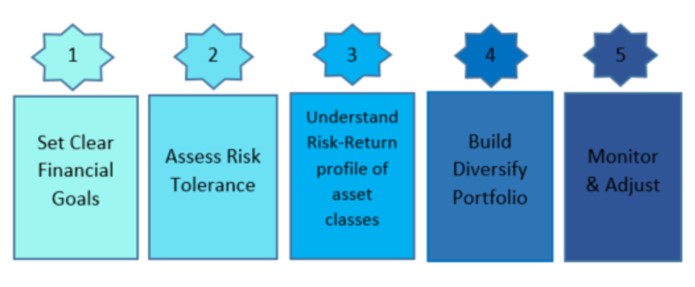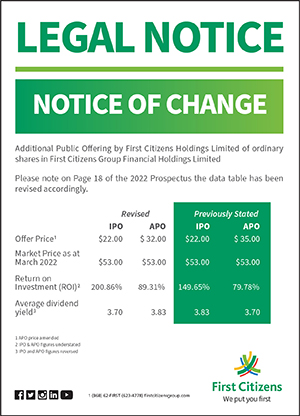INVESTING 1O1
Commentary

Investing is a way to grow money over time through the purchase and sale of financial instruments such as stocks, bonds, and mutual funds. It involves allocating money into various assets with the expectation of generating returns over time. Investing is important for achieving financial goals, such as saving for university, a down payment on a house, or retirement. However, investing can be complex and daunting for beginners. It is important to choose investments that align with one’s goals, risk tolerance, and time horizon. Investors must bear in mind that all investments carry some degree of risk, and it is important to understand the nature of risk and how to effectively manage it. By better understanding the basics of investing, individuals can make informed investment decisions and achieve long-term financial success.
Steps in the Investment Process
The first step to investing involves setting clear financial goals. These goals may include short-term objectives, such as purchasing a car or enjoying a vacation, or long-term goals, like acquiring a home and preparing for retirement. It is essential to quantify these goals by specifying exact amounts. This quantification is crucial as it enables individuals to calculate the required savings or regular investment amounts necessary to achieve their objectives.
In addition to establishing financial goals, individuals should assign specific timeframes to each objective. These deadlines play a vital role in prioritizing financial goals, taking into account their urgency and significance. They help individuals determine which goals to emphasize and the required savings or investment amounts necessary to achieve them within the specified timeframe. For instance, short-term goals often demand more substantial contributions in the near future, while long-term goals can benefit from a consistent and gradual investment approach that capitalizes on the power of compounding over time. Compounding is a powerful financial concept that refers to the process of earning returns not only on the initial investment but also on the accumulated earnings from previous periods. It’s often described as “earning interest on interest.”
It is recommended to conduct the necessary research on the various investment types before any monies are invested, thus investors need to know about different types of investments, how they work and their risk and return profile. For example, when an investor buys a stock, they are buying a piece of a company. Stocks trade on exchanges and its price tends to fluctuate in value regularly, which can result in substantial gains and losses and are riskier. Conversely, bonds are essentially loans investors give to governments or companies. In return for the loans, the bond issuers pay investors interest (coupon) at a fixed rate and return the initial investment (the principal) when the bond matures. This fixed interest payment provides a level of predictability and income stability that stocks do not offer. Another type of investment are mutual funds and Exchange-Traded Funds (ETFs) which are pool investments from multiple investors which is then invested into various asset classes. These funds are managed by experts and offer a convenient way to have a diverse mix of assets.
Knowing the return and risk characteristics of the various investments is important in selecting the assets that will be required to accomplish the financial goals. For goals that need to be reached in a short time, there is not much time to recover if things do not go well. So, it is safer to choose investments that are not too risky for these short-term goals. Consequently, conservative investments are preferred for short-term goals. On the other hand, for long-term goals, like those that will take many years, there’s more time to make up for any losses. Thus it would be wise to select investments that might have more risk but also more potential for higher returns for long-term goals.
Armed with this knowledge, the next step for investors involves building a diversified portfolio. Diversification functions as a risk management strategy that shields individuals from the potential downsides of concentrating all their financial resources in a single investment. By dispersing their investments among various asset classes, industries, and geographic regions, a diversified portfolio lessens the impact of poor performance in any one investment or sector. This risk mitigation is of utmost importance, given the unpredictable nature of financial markets, which can be influenced by economic conditions, geopolitical events, and various other factors. Diversification not only aids in preserving capital during market downturns but also evens out the ups and downs in investment returns over time.
The investment process extends beyond choosing and buying securities. Equally vital is the ongoing monitoring and adjustment of the portfolio, which assists investors in maintaining their course toward achieving their financial objectives. As time passes, an individual’s financial goals may shift due to life events such as marriage, the arrival of children, retirement planning, or unforeseen expenses. Monitoring provides investors with the means to confirm that their investment strategy remains aligned with their changing financial objectives.
In addition to the passage of time and the inevitable change in financial objectives, financial markets fluctuate on a daily basis, with asset values rising and falling due to economic conditions, geopolitical events, and other factors. Resultantly, the asset weights in the portfolio may drift from their intended asset allocation over time. To ensure the objectives are achieved, adjustment to the portfolio may be needed that may necessitate selling assets that have performed well and buying assets that have underperformed to bring the portfolio back to its target allocation. This helps maintain the desired risk-return profile.
Figure 1: Steps in the Investment Process

Investing is a powerful tool for building and preserving wealth, achieving financial goals and securing one’s future. By understanding the basics, setting clear goals, assessing risk tolerance, conducting thorough research to understand the investment characteristics of the various assets, diversifying, and rebalancing periodically, investors can navigate the complexities of financial markets with confidence. As with any endeavour, continuous learning and adaptation are key. With diligence and a well-informed approach, individuals can harness the potential of investing to achieve their financial dreams.
DISCLAIMER
First Citizens Bank Limited (hereinafter “the Bank”) has prepared this report which is provided for informational purposes only and without any obligation, whether contractual or otherwise. The content of the report is subject to change without any prior notice. All opinions and estimates in the report constitute the author’s own judgment as at the date of the report. All information contained in the report that has been obtained or arrived at from sources which the Bank believes to be reliable in good faith but the Bank disclaims any warranty, express or implied, as to the accuracy, timeliness, completeness of the information given or the assessments made in the report and opinions expressed in the report may change without notice. The Bank disclaims any and all warranties, express or implied, including without limitation warranties of satisfactory quality and fitness for a particular purpose with respect to the information contained in the report. This report does not constitute nor is it intended as a solicitation, an offer, a recommendation to buy, hold, or sell any securities, products, service, investment, or a recommendation to participate in any particular trading scheme discussed herein. The securities discussed in this report may not be suitable to all investors, therefore Investors wishing to purchase any of the securities mentioned should consult an investment adviser. The information in this report is not intended, in part or in whole, as financial advice. The information in this report shall not be used as part of any prospectus, offering memorandum or other disclosure ascribable to any issuer of securities. The use of the information in this report for the purpose of or with the effect of incorporating any such information into any disclosure intended for any investor or potential investor is not authorized.
DISCLOSURE
We, First Citizens Bank Limited hereby state that (1) the views expressed in this Research report reflect our personal view about any or all of the subject securities or issuers referred to in this Research report, (2) we are a beneficial owner of securities of the issuer (3) no part of our compensation was, is or will be directly or indirectly related to the specific recommendations or views expressed in this Research report (4) we have acted as underwriter in the distribution of securities referred to in this Research report in the three years immediately preceding and (5) we do have a direct or indirect financial or other interest in the subject securities or issuers referred to in this Research report.

